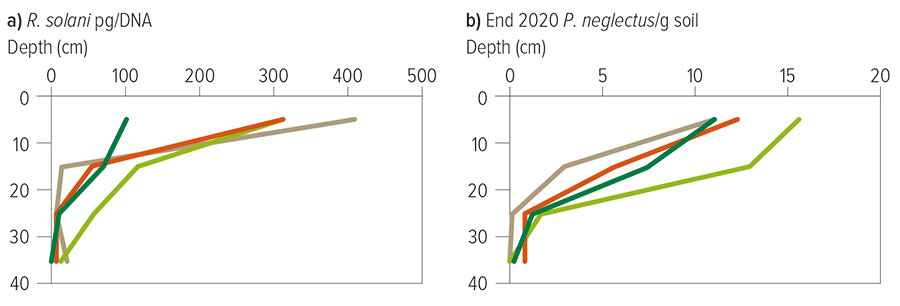Mechanical soil amelioration to remediate soil constraints such as acidity and compaction can affect soil-borne nematode pests and fungal pathogens (NPFP). Anecdotal evidence suggests a wide range of responses; some growers found NPFP increased, others thought they decreased. The issue is further confused by weeds, which are generally more prevalent in those fields with high levels of soil disease. Researchers are investigating how mechanical soil amelioration affects the distribution, populations and long-term survival of NPFP, and how both amelioration and soil-borne pests interact with weeds.
Research at sites near Darkan and Yerecoin in Western Australia studied how certain NPFP responded to mechanical soil amelioration. Using paddocks with existing physical and biological constraints, researchers trialled three treatments:
- deep ripping – two-metre-wide Agrowplow deep ripper capable of working to a depth of 45 centimetres;
- mixing – Imants 4m-wide rotary spader at Yerecoin, ripping and ploughing at Darkan; and
- inversion – three-furrow Kverneland mouldboard plough.
The yellow sand at Yerecoin had subsurface compaction and subsoil acidity. The duplex sandy gravel at Darkan was water repellent and had a high gravel content. The high gravel content at the Darkan site meant compaction could not be assessed.
Researchers studied how the various tillage treatments impacted survival and distribution of:
- root lesion nematode (RLN – Pratylenchus neglectus, P. quasitereoides);
- cereal cyst nematode (CCN – Heterodera avenae) (Yerecoin only);
- Rhizoctonia solani (AG8) (causes Rhizoctonia bare patch); and
- annual ryegrass (Lolium rigidum), great brome (Bromus diandrus) and barley grass (Hordeum spp).
Soil samples were collected in 10cm increments to 40cm, immediately after mechanical soil amelioration and over the next two seasons, 2019 and 2020.
Pests, diseases and weed seeds move with topsoil
Mechanical soil amelioration redistributed NPFP. Soil inversion, the most intensive amelioration treatment, had the greatest impact on NPFP in the topsoil. At both sites, soil inversion buried the topsoil with R. solani and RLN and brought NPFP-free subsoil to the surface.
Soil mixing had more of an impact than deep ripping, generally decreasing NPFP populations in the topsoil and increasing them deeper in the soil (see Figure 1). Mixing was more effective for R. solani than nematode pests, particularly in the sandy soil at Yerecoin.
R. solani levels remained lower in the topsoil compared to the non-ameliorated control plots. CCN populations showed limited change in the first season but had lower populations in the topsoil at the end of the second season. As soil mixing distributes the topsoil more evenly throughout the profile, NPFP populations were higher throughout the profile than with the other treatments.

Figure 1: Effect of soil amelioration on Pratylenchus neglectus and Rhizoctonia solani AG8 populations to depth (zero to 10cm, 10 to 20cm, 20 to 30cm, 30 to 40cm) after two seasons of growing a susceptible cereal crop, 2020. Amelioration treatments were soil inversion (dark green), deep plough (orange), soil mixing (light green) and un-ameliorated control (brown).
As deep ripping had the least impact on topsoil movement, it had the least impact on NPFP redistribution. Rhizoctonia solani and RLN increased in the subsoil, but changes in the topsoil were minimal and transient (Figure 1).
The deep ripping and control treatments had the most weed seeds in the top 10cm. Deep mixing distributed weed seeds from zero to 40cm depth, although most seeds were at zero to 10cm. Full soil inversion buried the seed to 10 to 20cm at both sites.
Even though the soil inversion reached depths of 40cm, weed seeds did not get buried below 20cm. As few weeds successfully emerge from deeper than 10cm, the result was deep ripping stimulated weed emergence, deep mixing slightly reduced weed density and soil inversion reduced weed density by 90 to 100 per cent.
How long the effects last
How long the effects of mechanical amelioration last could depend on the degree of soil mixing, soil type and which NPFP is present. In these trials, deep ripping had little effect on the biological constraints present in the topsoil and increased weed issues at both sites over two years. Some NPFP persisted in the subsoil over the two years.
With mixing and inversion, changes in NPFP populations were still evident after two years at both sites. Rhizoctonia solani remained lower in the new topsoil after soil inversion. RLN may have been recolonising the sandy Yerecoin topsoil. Weed density remained very low in the full inversion treatments over two years. However, even though emergence at 10 to 20cm is reduced, some weed seeds manage to successfully establish from this depth. This results in a gradual increase in weed density over time.
Impacts on crops
Soil inversion improved crop performance in both seasons, with improved grain protein percentage and yield. The result could stem from better root growth as lower NPFP in the topsoil allows the seminal and crown roots to grow more quickly.
Conclusion
Mechanical soil amelioration redistributes NPFP, moving populations with the topsoil. Soil amelioration increased NPFP at depth (10 to 40cm) where they are not usually found in WA soils. Research is ongoing to understand how these NPFP population changes could affect pest and disease management strategies.
Weed seeds are not as easy to place at depth (20 to 40cm) as previously thought. Different soil amelioration techniques will require custom integrated weed management programs.
More information: Sarah Collins (soilborne pests), sarah.collins@dpird.wa.gov.au; Catherine Borger (weeds), catherine.borger@dpird.wa.gov.au
This article was produced as part of the GRDC ‘Maintain the longevity of soils constraints investments and increase grower adoption through extension – western region’ investment (PLT1909-001SAX). This project is extending practical findings to grain growers from the five-year Soil Constraints – West suite of projects, conducted by the Department of Primary Industries and Regional Development with GRDC investment.

























































